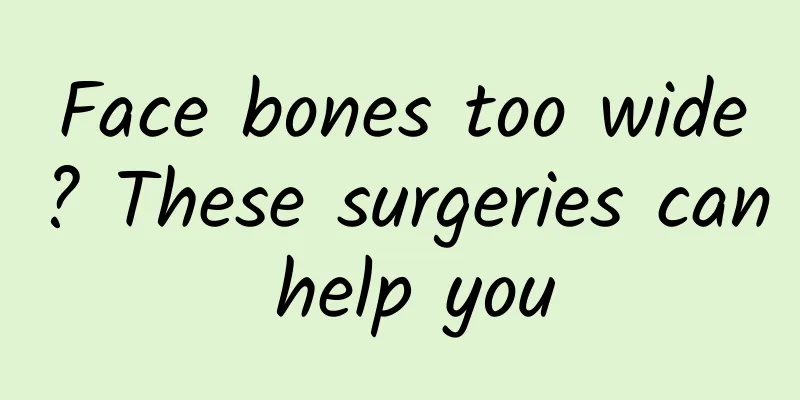Face bones too wide? These surgeries can help you

|
Having an exquisite small V-face is the dream of every beauty-loving lady, but wide facial bones fundamentally limit the way to achieve beauty, so people are eager to find effective methods. 3D zygomatic bone rotation and reduction, zygomatic arch and zygomatic arch reduction surgery, and zygomatic arch inward push are the most common and effective face-slimming surgeries today. Although there are certain risks, as long as there are no unexpected situations during the surgery and you take good care of yourself and take some precautions after the surgery, you can achieve face slimming through surgery and have a small V-shaped face, making you more confident about your face. 1. 3D zygomatic bone rotation reduction surgery The zygomatic bone is the widest part of the face, so if zygomatic bone surgery is done to reduce this part, the width of the face will also be reduced. However, if only the arched part is shortened, the effect will not be obvious enough. The area around the eyes should also be shortened, including the 45° cheekbones, so that the effect of reducing the face shape will be obvious. (1) Surgical method During the operation, an incision is first made in the oral cavity, the cheekbone area is cut, and then an incision is made at the temple area. After the incision is made at the lateral cheekbone, the whole operation is pushed inward to improve the cheekbone and zygomatic arch area. By connecting the masseter muscle and fixing the cheekbone, the chance of facial sagging after the operation is reduced. (2) Advantages of surgery And because the surgical incision is relatively hidden. Therefore, it is difficult to see the surgical scars after the operation. In addition, facial swelling after zygomatic bone surgery is very small and will not affect normal life. 3D zygomatic bone rotation surgery can improve the zygomatic bone area in all aspects. While reducing the zygomatic bone, it can also make the face more three-dimensional, so the effect after the operation is very natural. 2. Zygomatic arch and zygomatic bone reduction surgery The zygomatic bone is located below and outside the eye socket. It is diamond-shaped and forms the bony protrusion of the cheek. The temporal process of the zygomatic bone connects posteriorly to the zygomatic process of the temporal bone to form the zygomatic arch. The zygomatic arches are located on both sides of the craniofacial bones. They are arched outwards with sharp upper edges that are easy to palpate. The zygomatic bone has four processes: the frontosphenoidal process, the maxillary process, the temporal process, and the orbital process. It affects facial beauty primarily through its relationship with the nose, temples, and cheeks. (1) Surgical method Zygomatic bone and zygomatic arch plastic surgery is to reduce and lower the enlarged zygomatic bones to beautify the facial lines. The "zygomatic body" and "zygomatic arch" determine two important visual angles and also affect the beauty of the face shape. After the operation, not only the cheeks are greatly reduced and the visual effect is obvious, but the operation is completely performed in the mouth, reducing the number of wounds. 1. Measure the height-to-width ratio of the facial shape and the height-to-width ratio of the bony surface; 2. Two methods: intraoral and extraoral (intraoral approach using the maxillary vestibule groove, extraoral approach using the hairline coronal incision). The operation is performed under general anesthesia. The intraoral approach is to incise the mucosa and submucosal tissue from the buccal side of the buccal gingival sulcus to the periosteum. The incision is 4 to 5 cm long. After hemostasis, a periosteal elevator is used to peel along the periosteum to the infraorbital margin and lateral orbital margin. When approaching the infraorbital foramen, be careful not to damage the infraorbital nerve. Then peel along the lateral side of the zygomatic bone toward the zygomatic arch to expose the inner 1/2 of the zygomatic arch; 3. Use a deep right-angle retractor to expose the lateral and inferior orbital margins, and use methylene blue to mark an arc-shaped osteotomy line on the lateral orbital wall 8 mm from the orbital margin, extending inward and downward to the outer inferior edge of the maxillary process of the zygomatic body, with an osteotomy width of 10 to 15 mm. 4. Use a micro saw or split drill to cut the zygomatic bone along the osteotomy line. The osteotomy surface should be about 45° to the bone surface. Remove the cut bone to facilitate the close integration of the two sections; 5. After the zygomatic bone is cut off, a 5 mm incision is made in the skin at the front edge of the hairline at the temples. Use mosquito forceps to bluntly separate the deep part to the zygomatic arch bone surface, and then insert a small osteotome into the incision to gently cut off the distal end of the zygomatic arch, taking care to keep the broken end unchanged; 6. Drill holes in the zygomatic body, the outer edge of the orbital wall and the infraorbital rim and then ligate and fix with fine steel wire; 7. After sufficient hemostasis, use No. 1-0 sutures to suture the submucosal tissue and No. 3-0 sutures to suture the mucosa. (2) Postoperative care After zygomatic bone grinding surgery, the effect is very obvious and it will not affect the normal life of the patient. Except for the pain on the first day of the surgery, the pain will gradually disappear from the second day. However, there will be severe swelling within 2 to 3 days after the surgery, which will take about a week to subside. It will not cause any impact on normal work and life. 3. Zygomatic arch push-in The zygomatic arch reduction surgery mainly achieves the purpose of zygomatic arch reduction through zygomatic bone osteotomy, zygomatic bone flattening and zygomatic and maxillary osteotomy. Generally, zygomatic arch reduction surgery and subperiosteal rhytidectomy are performed at the same time. Surgery precautions Before surgery: the patient should be in good health, without organic lesions of important organs, infectious diseases or other body inflammations; surgery should be avoided during the menstrual period for women; facial frontal and lateral photographs should be taken routinely for postoperative comparison and efficacy evaluation, and a three-dimensional head CT scan can be performed if conditions permit. Take zygomatic bone X-ray to understand the development of maxillary sinus. In some individual cases, a facial mold should be taken to accurately measure the amount of bone that needs to be removed from the zygomatic bone. Aspirin and other drugs can cause increased bleeding and should be discontinued for a period of time before surgery. After surgery: Since the effect of the anesthetic will not disappear immediately, you may feel sleepy after the surgery; apply ice to the surgical site for 3-4 days to reduce swelling; avoid getting the surgical site wet within one week, and you can wash your hair after four days, but do not rub the hair removal site too hard; avoid spicy and irritating foods. This is all I have to say about how to shape beautiful cheekbones and zygomatic arches. I believe everyone has a good understanding. A beautiful face needs coordination. An exquisite small V-face plus beautiful cheekbones and zygomatic arches will greatly enhance your charm. |
<<: Do you know the cause of psychological hair loss?
>>: Cervical lymphoma has these symptoms, early detection and early treatment
Recommend
What causes pain in both arms?
Most people should have felt the pain in their ar...
What are the effects and functions of vinegar and five spirit fat
Many people have never heard of vinegar and angel...
Groin rash
There are often some problems on the human body t...
Why does bleeding occur during pregnancy?
A small number of pregnant women will experience ...
What are the symptoms of lung tumors? It turns out there are 7 types
Lung cancer is a disease with a relatively high i...
Frequent urination after taking anti-inflammatory drugs
Our body is a relatively complex structure. Due t...
Symptoms of testicular nodules
Many people get scared when they hear the word &q...
The efficacy of wild vegetables
Goat's foot grass is distributed in Shaanxi P...
Will the umbilical cord change at the edge of the placenta?
Many unexpected problems can occur during pregnan...
Cancer transgenerational inheritance
In life, there are many people who always have th...
What foods are suitable for patients with cerebral hemorrhage?
Patients with cerebral hemorrhage should pay atte...
The efficacy of licorice and wolfberry
I believe everyone is familiar with licorice. Lic...
The efficacy of leek seeds soaked in wine, drinking regularly can treat these diseases
Among the various methods of brewing wine, the ef...
I feel like there is something hard in my throat.
If you have a growth in your throat, it could be ...
How to treat lumbar spine injury_How to recover from lumbar spine injury
Lumbar spine problems can be said to be a problem...









